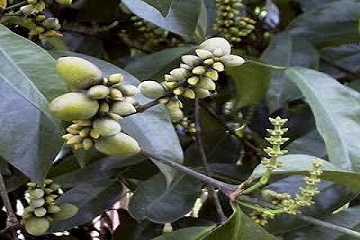A Group of IPB Students Utilized Melinjo skin (Gnetum gnemon Linn.) to lower Uric acid levels

Uric acid is a chemical produced when your body breaks down foods that contain organic compounds called purines. Mammals other than high-level primates have a uratase, or uricase or factor-independent urate hydroxylase, catalyzes the oxidation of uric acid to 5-hydroxyisourate. Of all animals that include meat in their diet, humans are the only animal that is unable to break down uric acid to allantoin. This is due to the fact that humans do not possess the necessary enzyme uricase. This leads to an increased possibility of an accumulation of uric acid in the body when animal products are eaten.
High blood concentrations of uric acid can lead to gout and are associated with other medical conditions including diabetes and the formation of ammonium acid urate kidney stones. The uric acid levels that exceed the solubility limit, will lead to crystallization of sodium veins in soft tissue and joints called gout. To manage long-term gout and prevent future attacks, we must take drugs called xanthine oxidase inhibitors. One of the synthetic drugs used for uric acid therapy is allopurinol. This drug has several side effects, such as fever, chills, leukopenia, and indigestion. It needs an alternative medicine that has better treatment activity and low side effects.
Traditional medicines derived from plants generally have lower side effects than chemical drugs. Chintia Ayu Puspita, a student of Bogor Agricultural University (IPB) together with her team consists of Syfa Zulaeha, and Dandung Wasana, proposed funding support for Program Kreativitas Mahasiswa bidang – Penelitian (PKM-P Student Creativity Program for Research) to conduct research program to investigate beneficial effects of natural ingredients of Melinjo skin (Gnetum gnemon Linn.) to lower Uric acid levels.
"Commonly people say that uric acid is a disease. Uric acid normally dissolves in the blood, processes through the kidney, and leaves the body in the urine. Gout, or pirai in Indonesian, is a painful disease that occurs when uric acid, a normal waste product, builds up in the blood and forms crystals in the joints and/or kidneys. Uric acid is a powerful antioxidant and is a scavenger of singlet oxygen and radicals. If the body makes extra uric acid, or if the kidneys cannot clear enough of it, then uric acid levels in the blood will become too high, a condition known as hyperuricemia, "said student of Department of Biochemistry, Faculty of Mathematics and Natural Sciences of Bogor Agricultural University (FMIPA IPB).
G. gnemon is known as a plant that triggers to increase uric acid levels, but the various compounds in the skin melinjo allegedly can lower uric acid levels. Melinjo (Gnetum gnemon L.) seed extract (MSE) containing trans-resveratrol (3,5,4'-trihydroxy-trans-stilbene) and other derivatives exerts various beneficial effects, and recent findings has revealed that G. gnemon contains bioactive compounds, such as saponins, tannins, and flavonoids, and stilbenoids. Sri Wulandari, (2012) stated that the empirical research also revealed that the skin of G. gnemon contains an ascorbic acid, tocopherol, flavonoids, saponins and polyphenols as antioxidants to increase inhibition activity of xanthine oxidase. "The reason we utilize G. g G. gnemon nemon skin as it contains high purine, so the community assumes any component of G. gnemon for example leaves, skin, seeds can increase uric acid levels, but actually the skin of G. gnemon has a reverse function, "said Chintia.
Chintia added, no in-vivo studies have examined the impact of G. gnemon skin uric acids level. "There have research programs investigating the content G. gnemon extract containing . bioactive compounds, such as saponins, tannins, and flavonoids, and stilbenoids G. gnemon seed contains an abundance of resveratrol (stilbenoid) mainly in the form of dimers (gnetin C). The skin of young G. gnemon was taken to change the public's assumption that G. gnemon will increase the uric acids, "she said.
The team implemented their experiment using 25 white male rats (Rattus norvegicus). "We use animal experiments directly, we use white rats. The fresh edible parts (leaves and seeds) of G. gnemon were taken, then dried for extraction. Process of extraction of seeds of G. gnemon used Maseration. This method involved soaking plant materials (coarse or powdered) in a stoppered container with a solvent and allowed to stand at room temperature for a period of minimum 3 days with frequent agitation way, and render it into a paste. The thick extracts then were administered for mice, "said Chintia. A total of 25 rats were divided into two groups, a standard group consisting of 5 rats and a group of 20 rats. Standard group is given standard feed. Group of 20 rats divided into three groups, namely positive control group, negative control and treated group.
The positive control group consisted of 5 rats fed by high purine and allopurinol. The negative control group consisted of 5 rats fed by high purine without extracts of G. gnemon and allopurinol skin. The treated group is a group of rats fed high purine feed and also G. gnemon fruit skin extract. The treatment group was subdivided into two groups based on the dosage of G. gnemon fruit skin extract according to Safwan (2016), i.e. dose of 6.48 mg / kg body weight, and 51.8 mg / kg body weight with each dose given to 5 rats.
"The different treatments were also implemented, the group of normal mice were untreated with nothing, the positive control group was treated by the drug synthetic allopurinol, the negative control was not given the drug. Then the one-dose treatment group was given the drug we tested, the same dose group but the extract dose doubled from the first dose. The extracts were administered orally. After being treated for an hour, then they were checked their blood to see the decrease in uric acid levels. Those given extract with the drug were more effective in reducing uric acid levels. After that utilizing testing kit we tested the mice and hispathogically observed for its gout. At present, research is still in progress for the induction phase, "she explained.
The experiment was divided into two weeks of adaptation and four weeks treatment. During the experiment we measure the body weight and blood test once a week to determine the content of uric acid in these mice. "For mice there is a period of adaptation, induction and treatment. A two-week adaptation period and a seven-day induction period. Two methods were utilized to increase the level of uric acid, we provide chicken liver and potassium oxonate may be used as a uricase inhibitor in rats, as such enzyme can convert uric acid into water-soluble compounds through the kidney, and leaves the body in the urine, while rats have uratase, "Said Chintia.
This research is expected to trigger further research on the utilization of G. gnemon fruit skin for herbal medicine product from to prevent gout, for the advancement of science nd health. "Hopefully expected that our research program will be acceptable, convince that the G. gnemon skin can reduce uric acid levels. As eating G. gnemon skin in the long term is also much safer than allopurinol or other chemical drugs because of it has no side effects for kidneys and other organs. In future, we should make other innovation on other food products or anything consumable by humans, "said Chintia. (Wied)



